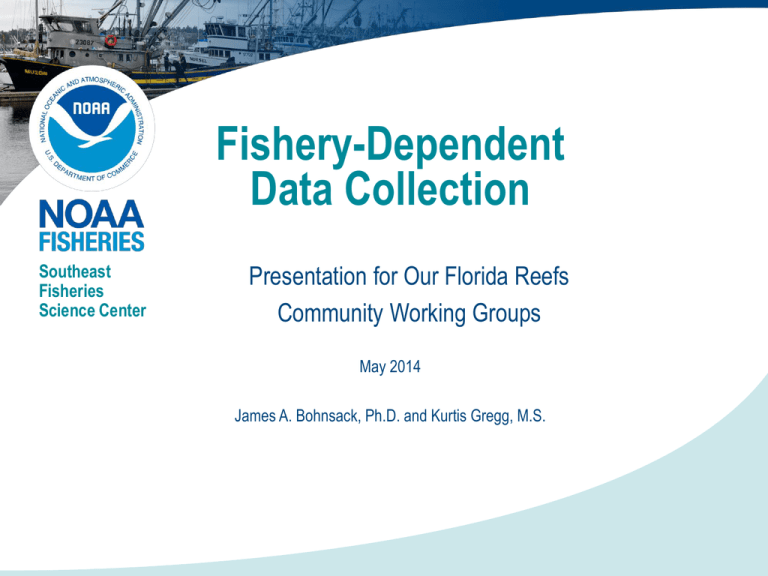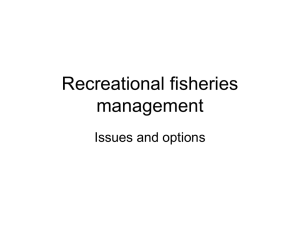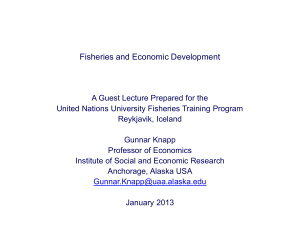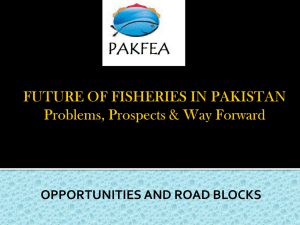
Fishery-Dependent
Data Collection
Southeast
Fisheries
Science Center
Presentation for Our Florida Reefs
Community Working Groups
May 2014
James A. Bohnsack, Ph.D. and Kurtis Gregg, M.S.
Important Distinction:
Fishery-Dependent (FD) data are obtained from a fishery.
FD data consist of catch, landings, bycatch, and other information about the fish
(for example, length and weight, tissue composition, and ear bones or scales for
aging) and the fishery, such as fishing effort, fishing gear, and fishing practices.
“What fish were caught on the reef?” “What was kept and what was released?”
Fishery-Independent (FI) data are obtained from research
surveys designed to be consistent over time.
FI data give a picture of resource condition, independent of fisheries. Data are
not affected by changes in fishing effort, fishing gear, or faulty reporting of
catches. F-I data may be collected by using fishing gear or by other techniques
such as video, visual, and acoustic methods to quantify information about fish.
“What fish are on the reef?” “How many?” What size?”
Fishery-Dependent Data Types
• Catch
• Landings – fish brought ashore
• Releases at sea (live)
• Discards and fish consumed at sea (dead fish, bait)
• Catch-effort – detailed information about the fishing activity
• Catch quantity and distribution (time and space)
• Effort quantity and distribution
• Catch rate analyses
• Biological information
• Size, age, sex, reproductive status, species composition and other
biological information on reproductive biology, stock structure,
ecological relationships.
U.S. Department of Commerce | National Oceanic and Atmospheric Administration | NOAA Fisheries | Page 3
Types of Data Collected by NOAA
• Fisheries related (FD and FI)
• Protected resources
(Endangered species–marine mammals sea turtles, etc.)
• Ecosystem Condition
(oceanography, habitat, other living marine resources)
Several state and federal programs collect fishery-dependent
data from both the commercial and recreational fishing sectors to
inform fisheries and ecosystem management decisions
Fishery-Dependent Data Problems
Problems with Fishery-Dependent data include:
• misreporting of catch, effort, and fishing activity
• changes in the fishery over time, such as changes in
regulations, markets, prices, and fishing gear.
Example of how this happens: An expansion of a fishery
to new areas may indicate that catch per unit effort has
increased, which is usually a sign that fish abundance is
increasing. Improved gear or fishing techniques can
produce a similar false conclusion.
FD data only provides part of
the picture: Biscayne Bay gray
snapper habitat shifts
Fishery independent data
Lc
Frequency
0.7
Fishery dependent data
0.6
Bay
0.5
Inshore Reefs
0.4
0.3
Offshore Reefs
0.2
0.1
0
3
6
9
12
YOY
15
18
21
24
27
30
Juveniles
1 yo
33
36
39
Adults
Lm
Lc
Minimum legal size
Length (cm)
42
45
60
SEFSC fishery-dependent commercial and
recreational data collection programs
• Accumulated Landings System (ALS) – Commercial
landings from dealers
• Southeast Headboat Survey – Recreational for Hire
(i.e. by the “head”) – Catch, Effort, Biological
• Fisheries Logbook System – Commercial Landings and
Effort
• Trip Interview Program – Commercial Statistics –
Biological
• Marine Recreational Information Program (MRIP)
Recreational – Catch, Effort, Biological
Fishery-Dependent Results
Average Annual Landings by Species
Landings of some stocks are predominately recreational and
other stocks are predominately commercial
U.S. Department of Commerce | National Oceanic and Atmospheric Administration | NOAA Fisheries | Page 8
Importance of releases for federally managed species in
Southeastern U.S.
South Atlantic recreational landings and releases (numbers)
U.S. Department of Commerce | National Oceanic and Atmospheric Administration | NOAA Fisheries | Page 9
NOAA-NMFS SEFSC Customers, Partners and Stocks
3 councils,
2 regional commissions
8 states, 2 territories
NMFS-SERO, NERO, NEFSC, S&T
Gulf of Mexico FMC
GSMFC, 5 states
South Atlantic FMC
ACCSP, NMFS-NERO,
4 states
Highly Migratory Species (HMS)
ICCAT
18 states, 2 territories
Caribbean FMC
GSMFC, 2 territories
Management Trends
•Fishery-dependent data are less available
due to fishery management actions such as:
•Closed seasons
•Minimum and Maximum size limits
•Smaller bag limits
•Gear restrictions
•Closed areas
•Need more fishery-independent data for
ecosystem-based assessments
•Use of spatial management measures has
increased
Fishery-Dependent
Catch and Effort Sampling
Sources:
Commercial
• self-reported vessel logs – most fisheries
• Automated
• Shrimp effort system (location and gear activity)
• Vessel Monitoring Systems (VMS, location only, GOM reef fish, pelagic longline
Recreational
• Marine Recreational Information Program– dockside interviews, phone
• Southeast Regional Headboat Survey– self-reported vessel logs, trip validation
• Recreational Billfish Survey– self-reported tournament logs
Partners and Programs
Commercial: SEFSC, US Coast Guard, Living Marine Resources, NMFS-Office of
Law Enforcement
Recreational: SEFSC, Florida Fish and Wildlife Conservation Commission
U.S. Department of Commerce | National Oceanic and Atmospheric Administration | NOAA Fisheries | Page 12
Fishery-Dependent Recreational
Catch Programs
• Logbook programs
• Southeast Region Headboat Survey
• Geographical range: NC-TX
• Self-reported catch
• Validated effort (trips)
• Recreational Billfish Survey (tournaments)
• U.S. permitted tournaments
• Self-reported catch and effort
• Census attempted
• Large Pelagic Survey (LPS)
• Telephone reporting via Atlantic Highly Migratory
Species, Recreational Reporting Line (RRL)
U.S. Department of Commerce | National Oceanic and Atmospheric Administration | NOAA Fisheries | Page 13
Recreational Catch Surveys
• Strengths
• Statistical surveys of recreational catch and effort
(e.g. MRIP and LPS) reduce bias in the dataset
• Headboat surveys are good at monitoring fishing
effort
• Concerns
• Little or no observer verification of reported
information
• Size and age of catch are needed but not
collected
• Released fish are primarily self-reported
• Southeast Region Headboat Survey (SRHS)
• Self-reported landings
• Highly Migratory Species phone survey
• Low participation rates
• Self-reported catch information
U.S. Department of Commerce | National Oceanic and Atmospheric Administration | NOAA Fisheries | Page 14
Recreational Catch Survey Issues
(landings and releases)
• Nearly all catch and effort data are self-reportedLittle or no observer verification of catch and
effort information
• Surveys are very difficult and expensive to
monitor recreational fisheries
• Surveys are intended to cover large areas that
may not be similar (for example, there are five
regions in Florida- NE, SE, Florida Keys, SW,
NW)
U.S. Department of Commerce | National Oceanic and Atmospheric Administration | NOAA Fisheries | Page 15
Released Catch Survey Data
Sources:
Self-reported
Commercial – most fisheries
Recreational – MRIP, LPS, SRHS
Scientific observers
• NOAA Southeast Fisheries Science Center (SEFSC):
• GOM: shrimp, reef fish, bottom longline, gillnet, pelagic longline
• Gulf and South Atlantic Fisheries Foundation: South Atlantic
vertical line survey (commercial bandit and rod and reel fisheries)
• MRIP(NOAA): for-hire
• Florida (FWC): for-hire
U.S. Department of Commerce | National Oceanic and Atmospheric Administration | NOAA Fisheries | Page 16
Released Commercial Catch
Comparison of self-reported vs observed data
Observer data provides a picture of numbers released compared to self-reported estimates
U.S. Department of Commerce | National Oceanic and Atmospheric Administration | NOAA Fisheries | Page 17
The Florida Marine Fisheries Trip Ticket Program
• Commercial fisheries landings and fishing effort data have
been collected by the state of Florida since November 1984.
• Florida law (Chapter 379.362(6), and Administrative Code
68E-5.002) requires that all sales of seafood products from
the waters of Florida must be reported on a Marine Fisheries
Trip Ticket at the time of sale.
• Trip tickets include information about the harvester, the dealer
purchasing the product, the date of the transaction, the
county in which the species was landed, time fished, and
pounds of each species landed for each trip. Completed
tickets are mailed to the Florida Fish and Wildlife
Conservation Commission.
Questions?







